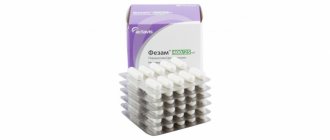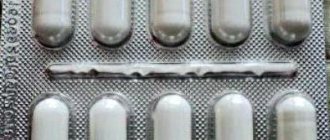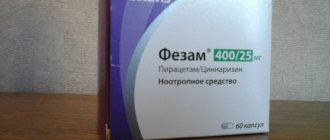Pharmacodynamics and pharmacokinetics
Stugeron belongs to the group of selective blockers of slow calcium channels, which have effects aimed at reducing the penetration of calcium ions into cells, reducing their accumulation in the cytolemma depot , as well as weakening the tone of smooth muscle tissue of arterioles and increasing the vasodilating efficiency of carbon dioxide .
Cinnarizine, by directly acting on vascular smooth muscle, reduces its response to biologically active substances ( angiotensin , adrenaline , dopamine , norepinephrine , vasopressin ). It is characterized by a vasodilating effect (especially for cerebral vessels), but does not significantly affect blood pressure . It has moderate antihistamine effectiveness, reduces the excitability of the vestibular system and the activity of the sympathetic nervous system. Reduces blood viscosity, increases the elasticity of erythrocyte membranes and the ability of erythrocytes to deform. Improves the resistance of muscle tissue to hypoxia .
Resorption of orally administered cinnarizine occurs in the stomach and intestines. Plasma Cmax is observed after 1-3 hours. Plasma protein binding is at the level of 91%. Complete metabolic transformations are carried out in the liver through the process of glucuronidation. cinnarizine metabolism are excreted 1/3 by the kidneys and 2/3 by the intestines. T1/2 is equal to 4 hours.
Pharmacological properties of the drug Stugeron
The active substance of the drug, cinnarizine, is a calcium channel blocker that reduces the tone of vascular smooth muscles, mainly cerebral arterioles. Has no effect on blood pressure and heart rate. Cinnarizine also inhibits the action of various vasoactive substances: norepinephrine, serotonin, etc., and also improves microcirculation by increasing the elasticity of red blood cells and reducing high blood viscosity. Increases cell resistance to hypoxia. It also has a weak antihistamine (H1-blocking) effect, prevents stimulation of the vestibular apparatus and the occurrence of acute attacks of dizziness. After taking the drug orally, the maximum concentration of cinnarizine in the blood plasma is achieved after 1–3 hours. Plasma protein binding is about 91%. Cinnarizine is completely metabolized in the body. The half-life is 4 hours. About 1/3 of the metabolites of cinnarizine are excreted in the urine, the rest in the feces.
Indications for use of Stugeron
Indications for use of Stugeron include:
- negative symptoms of cerebrovascular origin (tinnitus, feeling of dizziness , irritability , headaches of vascular origin);
- prevention of motion sickness syndromes ( kinetosis ), including air, road, and sea sickness;
- vestibular disorders ( tinnitus , Meniere's disease , dizziness , nausea/vomiting, nystagmus of labyrinthine origin);
- prevention of attacks of migraine-like pain ;
- peripheral circulatory disorders ( thromphlebitis , diabetic angiopathy , Raynaud's disease , trophic disorders, intermittent claudication ).
Indications for use of the drug Stugeron
Maintenance therapy for symptoms of labyrinthine disorders, including dizziness, nausea, vomiting, tinnitus and nystagmus; prevention of motion sickness; migraine prevention; maintenance therapy for symptoms of cerebrovascular origin, including dizziness, tinnitus, headache of vascular origin, communication problems, irritability, memory impairment and inability to concentrate; maintenance therapy for peripheral vascular disorders, including Raynaud's disease, acrocyanosis, intermittent claudication, microcirculation disorders, trophic and varicose ulcers, paresthesia, night muscle cramps of the lower extremities, feeling of coldness in the extremities.
Contraindications
The use of Stugeron is contraindicated in nursing and pregnant women, as well as in patients with personal hypersensitivity to its active ingredient ( cinnarizine ) or additional components.
It is not recommended to use the drug for the treatment of children under 5 years of age.
Treatment with cinnarizine requires caution in patients with Parkinson's disease .
Side effects
Some patients, when taking Stugeron tablets, experienced the following negative side effects of the therapy:
- drowsiness;
- dry mouth;
- fatigue;
- sweating;
- headache;
- skin rash;
- development of cholestatic jaundice ;
- depressive state;
- pain in the epigastric region;
- dyspeptic disorders;
- the occurrence of lupus-like syndrome ;
- allergic reactions;
- formation of lichen planus (very rare);
- weight gain;
- extrapyramidal disorders.
Side effects of the drug Stugeron
Transient drowsiness or disorders of the digestive tract are possible (these phenomena do not occur if the dose of Stugeron is increased gradually), including pain in the epigastric region (when taking the drug after meals, the frequency of this side effect decreases); headache, dry mouth, weight gain, sweating and allergic reactions are rarely reported. Isolated cases of the development of lichen planus, lupus-like reactions, and cholestatic jaundice have been described. In elderly patients, long-term use of the drug may result in the appearance or increase in the severity of existing extrapyramidal disorders, sometimes in combination with depressive reactions. In such cases, it is recommended to stop taking the drug.
Instructions for use of Stugeron (Method and dosage)
Stugeron tablets, instructions for use recommend oral administration after meals.
For patients over 12 years of age, the following dosage regimens are recommended.
In the case of treatment of conditions associated with cerebral circulatory disorders , 25-50 mg (1-2 tablets) of the drug are prescribed three times a day.
For the treatment of vestibular disorders, a three-time daily dose of 25 mg (1 tablet) is indicated.
Peripheral circulatory disorders require therapy with 50-75 mg (2-3 tablets) three times every 24 hours.
In order to prevent kinetosis, 25 mg (1 tablet) is prescribed half an hour before the intended trip (if necessary, take a similar dose 6 hours later).
In a maximum of 24 hours, you can take 225 mg (9 tablets) of Stugeron.
For patients aged 5-12 years, it is recommended to prescribe half (1/2) the dose of the dosage taken by adults.
In case of personal hypersensitivity of the patient, treatment should begin with a half (1/2) dose and gradually increase it to the optimal dose.
The therapeutic course of taking Stugeron usually takes from several weeks to several months.
Use of the drug Stugeron
Inside after meals. For cerebrovascular accidents, the drug is prescribed 25 mg 3 times a day. For peripheral circulatory disorders - 50–75 mg 3 times a day. For labyrinthine disorders, Stugeron is used at an initial dose of 25 mg 3 times a day and, if necessary, gradually increases the dose. For “motion sickness” - 25 mg 30 minutes before the trip with repeated doses every 6 hours. Children aged 5–12 years are prescribed 1/2 dose of the drug used in adults. The maximum daily dose of Stugeron for adults should not exceed 225 mg.
special instructions
At the beginning of Stugeron therapy, the patient is advised to refrain from any activities that are potentially life-threatening, including driving.
The antihistamine activity of cinnarizine can cause a false positive result in anti-doping testing , as well as lead to the leveling of positive reactions when performing diagnostic skin tests , which requires discontinuation of Stugeron four days before the proposed test.
With prolonged use of cinnarizine, it is recommended to conduct periodic control examinations of the functionality of the liver / kidneys , as well as monitor the picture of peripheral blood .
Elderly patients taking cinnarizine are susceptible to the development of extrapyramidal disorders ( hypokinesia , limb tremors , increased muscle tone), and therefore, the identification of such negative symptoms requires discontinuation of the treatment.
Patients with Parkinson's disease can be prescribed Stugeron only in cases where the expected benefits of therapy significantly exceed the risk of worsening their disease state.
Special instructions for the use of the drug Stugeron
For Parkinson's disease, Stugeron is prescribed only in cases where the benefits of using the drug outweigh the risk of increasing the severity of the symptoms of this disease. Stugeron may cause drowsiness, so it is recommended to avoid simultaneous use of alcohol and CNS depressants; You should (especially when starting to take the drug) be careful when driving a vehicle or performing work that requires increased attention. Despite the fact that the teratogenic effect of Stugeron was not revealed in experimental studies, the use of the drug during pregnancy is recommended only in cases where the expected therapeutic effect outweighs the potential risk to the fetus. During breastfeeding, taking Stugeron is not recommended, since there is no data on the entry of cinnarizine into breast milk.
Analogs
Level 4 ATX code matches:
Betagis
Betaserk
Betaver
Westinorm
Westicap
Betagistine
Tagista
Vestibo
Cinnarizine
Analogues of Stugeron are represented by drugs similar to it in their main action:
- Cinnarizine;
- Aviomarin;
- Asniton;
- Avertid;
- Be-Steady;
- Akuver;
- Betagis;
- Betanorm;
- Betagistine;
- Vazoserk;
- Betaserk;
- Vergostin;
- Maxhistin;
- Vestagistin;
- Medogistin;
- Westinorm;
- Neurogin;
- Denoise;
- Tagista.
Stugeron or Cinnarizine - which is better?
In the case of comparing Cinnarizine (companies Veropharm, Tatkhimfarmpreparaty, Balkanfarm, Biosintez, Nizhpharm, etc.) and Stugeron (Gedeon Richter), which includes cinnarizine as an active ingredient, we can only talk about the degree of purification of these drugs. It is unfortunate, but today in this aspect domestic drugs are often inferior to their foreign counterparts, which is reflected in their reduced effectiveness and increased risk of side effects. Otherwise, all medicinal products with this active ingredient, apart from some differences in the composition of additional substances, are identical and can, if necessary, replace each other.
Reviews Stugerone
As a rule, reviews from those who took Stugeron for the treatment of any cerebrovascular disorders are positive. This drug, used according to indications for use and in recommended dosages, has really proven itself in terms of high efficiency and practical safety of use.
It was the minimal risk of side effects that made it possible to use Stugeron for children even in infancy, although this is contraindicated in the official instructions. Parents who leave reviews about Stugeron for infants on various Internet resources, in the vast majority of cases, confirm the high assessment of its action and safety of use.
Stugeron price, where to buy
The average price of Stugeron is 170 rubles.
- Online pharmacies in RussiaRussia
- Online pharmacies in KazakhstanKazakhstan
ZdravCity
- Stugeron tablets 25 mg 50 pcs. JSC Gedeon Richter
RUB 185 order
Pharmacy Dialogue
- Stugeron (25 mg tablet No. 50)Gedeon-Richter
186 RUR order
show more




